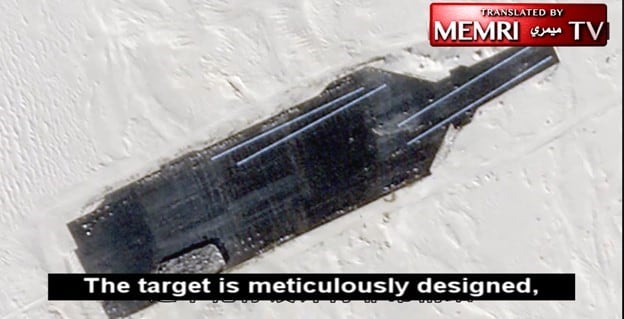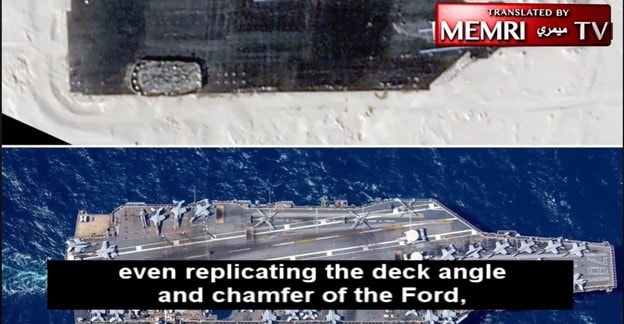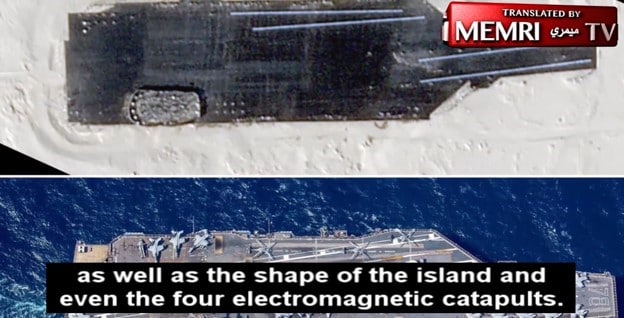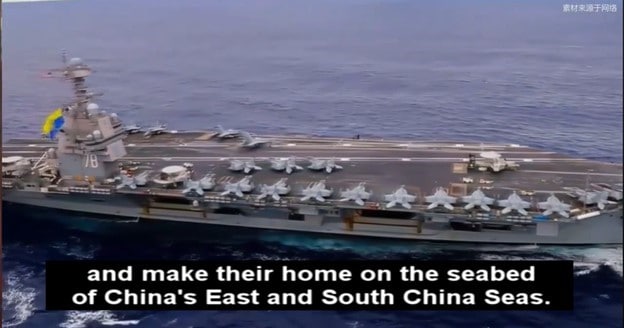
On January 7, 2024, Chinese military expert Wang Yunfei, who is a researcher at the China National Defense Policy Research Association and an expert in naval operations, posted a video to his Haokan account about the recently-revealed satellite image showing a replica of the USS Gerald R. Ford in a remote desert range in Xinjiang, China. The replica was apparently being used for target practice, and Wang said in the video that China is committed to simulating attacks on aircraft carriers and that China's rocket force has acquired substantial knowledge about the complex evasion maneuvers of these carriers. He also said that China, having already prepared a simulated Ford-class carrier in the desert, is "now waiting for the real Ford-class carriers to come and make their home on the seabed of China's East and South China Seas."
Wang Yunfei: "The USS Ford, an American aircraft carrier, has withdrawn from the Mediterranean Sea, and China has set up a 'home' for it in the desert. The USS Ford was photographed on January 5th leaving the Mediterranean Sea through the Strait of Gibraltar, heading west without looking back. According to U.S. officials, Ford is returning for redeployment. Whether it's for redeployment or rest, Ford is retreating. Along with it, the USS Carl Vinson also retreated. As we all know, the Philippines originally planned to invite it to join the joint patrol with Philippine vessels in the South China Sea. However, it did not participate and only sent a subordinate destroyer, the USS Sterett, as a token gesture. The withdrawal of these two U.S. aircraft carriers is part of the overall strategic deployment of the United States.
"U.S. carriers serve only the strategic interests of the U.S. and will not serve smaller countries. The U.S. will support the Philippines to a point, but it is unlikely to risk its own lives for the Philippines to seize those small islands and reefs. The U.S. will of course support Israel, but once it feels Israel can handle things on its own, it will call it a day. All this is to serve the strategic goals of the United States, to target the deployment of its military forces mainly at China, to contain China's development and growth, to prevent the unification of the two sides of the Taiwan Strait, and to undermine China's security environment.
"The top weapon of U.S. military threats against China is of course its aircraft carriers. China takes the top threat from the U.S. seriously, especially the new Ford-class carriers. According to the American [website] the War Zone, the U.S.-based Planet Labs captured the latest image of an aircraft carrier target in the Taklamakan Desert range in Xinjiang, China, on January 1 of this year, showing a full-size, black silhouette of the Ford aircraft carrier. The target is meticulously designed, even replicating the deck angle and chamfer of the Ford, as well as the shape of the island and even the four electromagnetic catapults.



"The report said that China set up different antennas on these 'carrier' mock-ups to simulate the electromagnetic signals emitted by the electronic equipment of carriers in transit. This may also be for the purpose of striking carriers, providing homing guidance similar to anti-radiation missiles for detecting electromagnetic waves. The War Zone did not mention whether the simulated mobile carrier had a mobile track underneath. Previously, U.S. media reported a turntable moving track simulating a Nimitz-class carrier in the Ruoqiang area, using a giant mobile target of the same scale to recreate a real combat environment. The carrier can travel more than 500 meters in less than a minute at a speed of 32 knots.
"China is serious about simulated attacks on aircraft carriers. We have already considered the complex scenarios of these carriers' evading maneuvers. Of course, the Americans are not that foolish. The Philippines wanted to use the USS Carl Vinson to threaten China in the South China Sea, but the Americans know in their hearts that China wants to take down even Ford-class carriers, making the Carl Vinson even more of a target for China's rocket force in the South China Sea. The Americans do not want to provide China with an opportunity for simulated targeting. So, they have backed out of their agreement with the Philippines. The nuances of great power confrontation are not something that little Marcos can understand. Since China has already set up a 'home' for the simulated Ford-class carriers in the desert, China is now waiting for the real Ford-class carriers to come and make their home on the seabed of China's East and South China Seas."
















